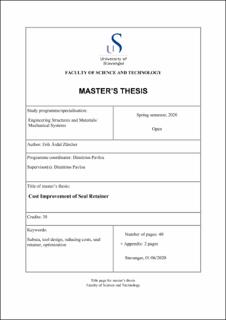| dc.contributor.advisor | Pavlou, Dimitrios | |
| dc.contributor.author | Zurcher, Erik Årdal | |
| dc.date.accessioned | 2021-02-16T10:18:25Z | |
| dc.date.available | 2021-02-16T10:18:25Z | |
| dc.date.issued | 2020-06 | |
| dc.identifier.uri | https://hdl.handle.net/11250/2728298 | |
| dc.description | Master's thesis in Mechanical Engineering | en_US |
| dc.description.abstract | The objectives of the thesis are to optimize the tip angle of the seal retainers and to determine cheaper materials that are appropriate for the application of the tool. Seal retainers are used to retain seals on valve blocks in subsea environments. The functionality of the tool must be maintained, while the tool must be optimized based on performance and costs.
Firstly, the thesis includes analysis of stresses to ensure sufficient strength of the tool. The major stresses in the seal retainer for various tip angles are evaluated. Both the analytical and numerical results agree. The 40 degrees tip angle is found to be superior. The proposed 40 degrees tip angle leads to a line contact between the retainer and the seal resulting in far lower contact stresses compared to point contacts. The determined stress results also inform about the necessary strength for the seal retainer. The required yield strength is determined to be unnecessarily high with the current tip angle of 45 degrees. If the tip angle is changed to the superior tip angle of 40 degrees, the strength requirement will be substantially lowered. In that case, the bending stress will be the limiting factor. The strength requirement of the retainer's material can potentially be lowered further by increasing the diameter of the pin. However, that will result in a costly initial investment.
Secondly, relatively many steel grades with martensitic structure from various treatments can achieve high strengths. However, the material of the retainer must also have sufficient corrosion resistance in the subsea environment. Hence, stainless steel is identified to be the only type of steel that can meet the corrosion resistance requirement. In addition, the current protective coating must be continued in being used for the retainer. With all the requirements considered, a list of the most appropriate stainless steels is presented. The list is obtained from evaluating the alloy surcharges of commercially available stainless steel grades over a one year period. The list is also based on the yield strengths of each stainless steel grade with various strength increasing treatments. The winner of the analysis is the stainless steel grade EN 1.4034. | en_US |
| dc.language.iso | eng | en_US |
| dc.publisher | University of Stavanger, Norway | en_US |
| dc.relation.ispartofseries | Masteroppgave/UIS-TN-IMBM/2020; | |
| dc.subject | subsea | en_US |
| dc.subject | tool design | en_US |
| dc.subject | reducing costs | en_US |
| dc.subject | seal retainer | en_US |
| dc.subject | optimization | en_US |
| dc.subject | maskinteknikk | en_US |
| dc.subject | maskinkonstruksjon | en_US |
| dc.title | Cost Improvement of Seal Retainer | en_US |
| dc.type | Master thesis | en_US |
| dc.subject.nsi | VDP::Teknologi: 500::Maskinfag: 570 | en_US |
